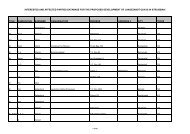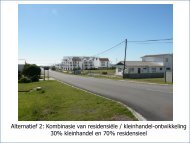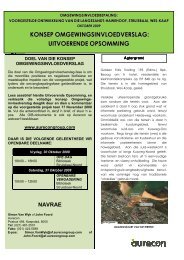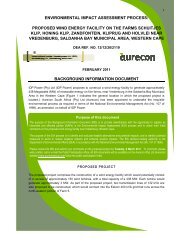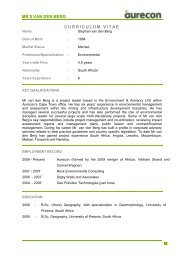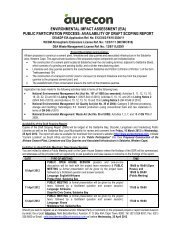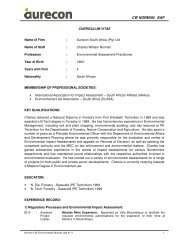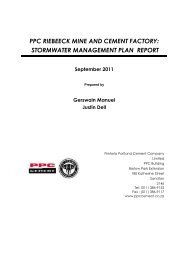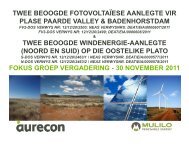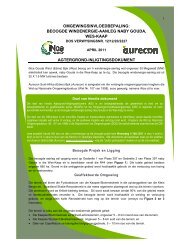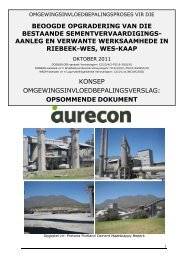Final EIAR - Aurecon AME Environmental | Environmental Projects
Final EIAR - Aurecon AME Environmental | Environmental Projects
Final EIAR - Aurecon AME Environmental | Environmental Projects
You also want an ePaper? Increase the reach of your titles
YUMPU automatically turns print PDFs into web optimized ePapers that Google loves.
Proposed Wind and Solar (Photovoltaic) Energy Facilities on Kangnas Farm near Springbok in the Northern Cape: Draft EIR 73<br />
4.2.3 Impact on bats<br />
Many bat species roost in large communities and congregate in small areas. Therefore, any<br />
major disturbances within and around the roosting areas can adversely impact individuals of<br />
different communities within the same population concurrently. Urban development and<br />
agricultural practices have contributed to a decline in bat numbers globally, as well as in South<br />
Africa. Wind energy facilities are known to impact on bats and as such the proposed projects<br />
could have an impact on any bats found on the sites. As such Werner Marais of Animalia<br />
Zoological & Ecological Consultation was appointed to undertake a bat specialist study. A field<br />
survey was undertaken from 18-22 July 2012. Bat activity was observed at dusk and at night.<br />
Bat echolocation calls were recorded on a continuous basis, during night and day time, while<br />
traversing the study area with a vehicle.The Bat Impact Assessment is included in Annexure G<br />
and the findings and re commendations are summarised below.<br />
a) Description of the environment<br />
The inselbergs found on site can prove useful as roosting sites for bats. The two small caves<br />
found in the study area can offer roosting space as well as the farm buildings. Precipitation in<br />
the area is very low, and channels or streams are temporary, such that surface water on this<br />
site is very limited. This reduces the likelihood of the use of the site for foraging. Drainage lines<br />
and open water sources are generally used for foraging<br />
The following bat species could possibly occur in the study area: Geoffroy’s horseshoe bat<br />
(Rhinolophus clivosus), Darling’s horseshoe bat (Rhinolophus darling), Egyptian slit-faced bat<br />
(Nycteris thebaica), Roberts’s flat-headed bat (Sauromys petrophilus), Egyptian free-tailed bat<br />
(Tadarida aegyptiaca), Natal long-fingered bat (Miniopterus natalensis), Angolan wing-gland bat<br />
(Cistugo seabrae), Long-tailed serotine (Eptesicus hottentotus), Temmink’s myotis (Myotis<br />
tricolor) and Cape serotine (Neoromicia capensis).<br />
The main method of bat detection involved the use of a bat detector which is a device that is<br />
capable of recording ultrasonic bat calls that is not always audible to the human ear for<br />
computer analysis afterwards. One species was identified and confirmed in the study area,<br />
using this method, during the site survey, namely the Egyptian free-tailed bat (Tadarida<br />
aegyptiaca). The Egyptian free-tailed bat is a very common bat and can typically be found<br />
roosting in crevices and roofs of houses. Their conservation status is of “Least Concern”.<br />
Figure 4.9 shows the bat sensitivity of various areas of the site.<br />
b) Potential Impacts<br />
Wind Energy Facility Potential Impacts<br />
Many bat species roost in large aggregations and concentrate in small areas. Furthermore, the<br />
reproductive rates of bats are also much lower than those of most other small mammals- usually<br />
only 1-2 pups per female annually. Therefore any major disturbance to a small area within which<br />
a bat population resides would impact on the whole population and the recovery of the<br />
population would be very slow. Since bats have highly sophisticated navigation by echolocation,<br />
it is not understood why they are hit by rotating turbine blades. A number of theories exist, one<br />
theorizing that under natural circumstances bats’ echolocation is designed to track down and<br />
pursue smaller insect prey or avoid stationary objects, not focus on unnatural objects moving<br />
© <strong>Aurecon</strong> (2012) No unauthorised reproduction, copy<br />
or adaptation, in whole or in part, may be made.<br />
P:\<strong>Projects</strong>\108495 Kangnas WEF & PV EIA's\3 Project Delivery\4 Reports\FEIR\FEIR 210213 <strong>Final</strong>.doc


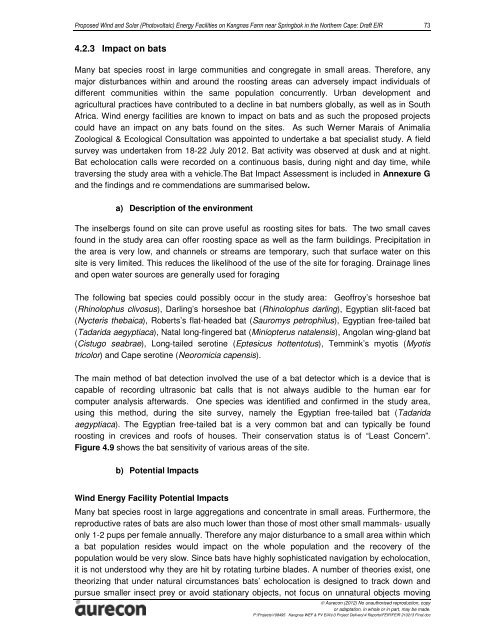
![CRR IV FEIR ~ 26042010 [FINAL].pdf - Environmental Projects](https://img.yumpu.com/21973020/1/184x260/crr-iv-feir-26042010-finalpdf-environmental-projects.jpg?quality=85)
